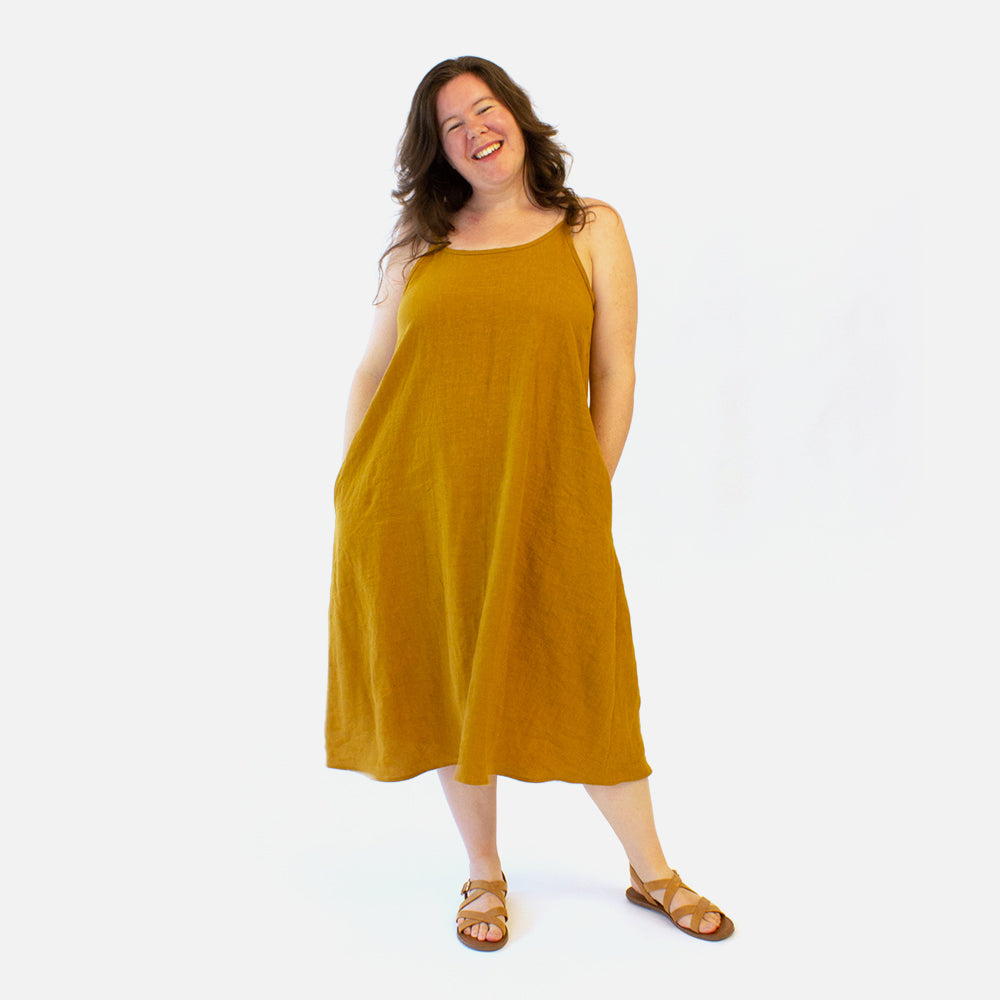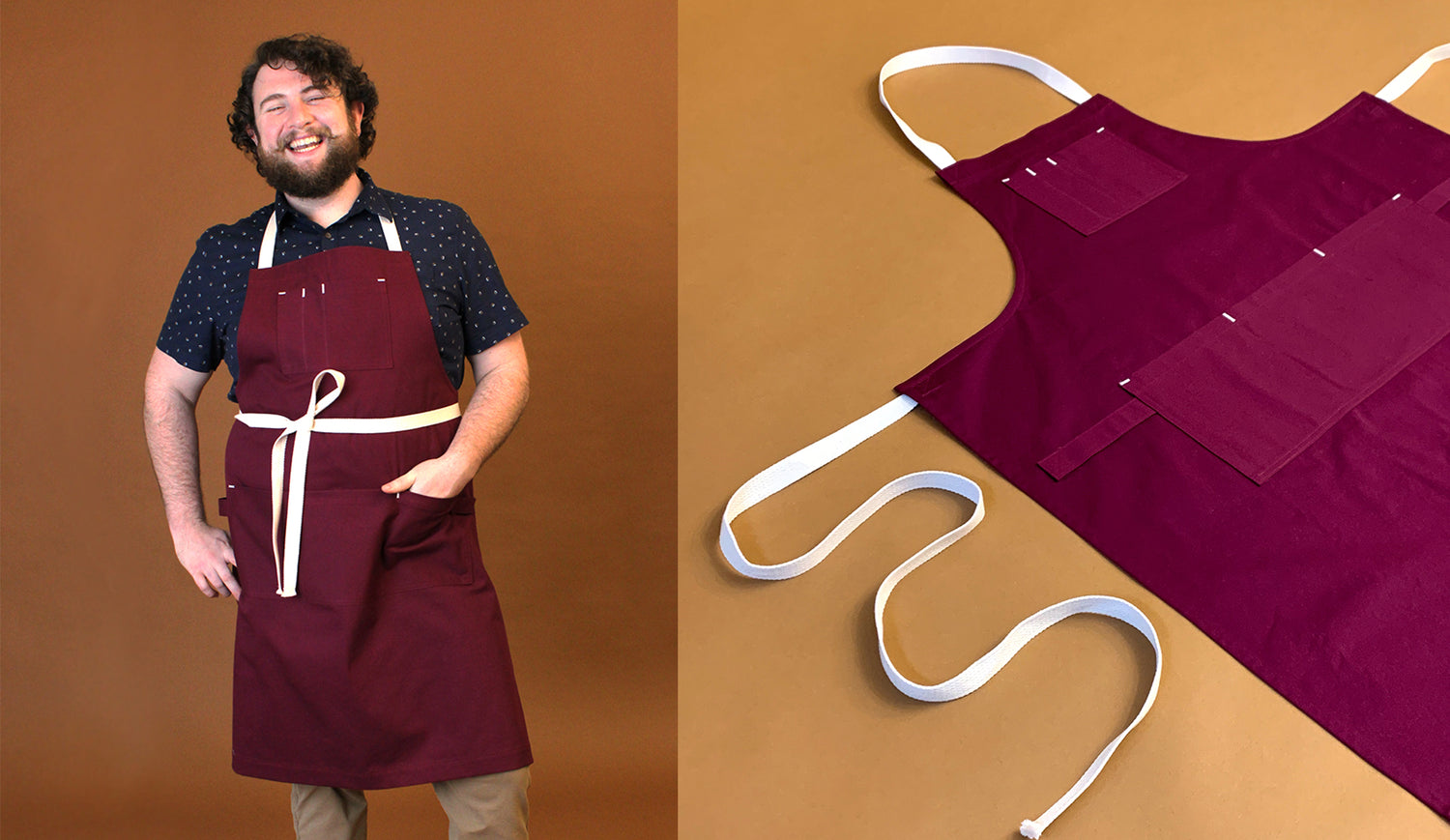
Whether you are sewing the Lawrence Top and Dress, the March Top and Dress, or one of our many pattern hacks, gathering is an essential sewing technique that you will come across again and again. It’s the secret to sewing gathered skirts, puffed sleeves, ruffles—and it’s easier to do than you might think! Today I want to show you three different techniques for how to sew gathers.

Basting Stitches
The first technique I’m going to show you is the one described in the March pattern instructions, and what you’ll probably find in most sewing patterns. That’s because it’s a great way to achieve even gathers without using extra materials—even if it does take a little longer than some of the other methods we’ll cover.

Pros: Controlled gathers, easy, doesn’t require extra materials.
Cons: Slower, requires unpicking stitches after the seam is sewn.
To start, you’ll want to set your machine to a basting stitch length (usually somewhere between 4-7 mm, depending on your machine), keeping in mind that:
A longer stitch length = faster, easier gathering
A shorter stitch length = slow, more precise gathering
The type of fabric you’re using can make a difference too. Lighter weight fabrics generally require shorter stitches, while heavier materials will need longer stitches. Personally, I find that about 4 mm is a nice balance, and it’s the setting I used here. If your machine can go higher, feel free to test different options on some scraps and see which one you like best.

You’re going to sew two lines of parallel basting stitches on either side of your seam allowance. For a 5/8” seam allowance, sew the first line of basting stitches 3/8” (1 cm) away from the raw edge and the second one 3/4” (1.9 cm) away. Leave long thread and tails and do not backstitch! This is really important to make sure you can pull the threads in the next step. Likewise, make sure you hold your thread tails out of the way so they don’t get caught in other stitches.


You should now have four thread tails on each side (eight total). Separate your bobbin threads (on the bottom) and your topstitch threads (on the top). I like to use a seam gauge, point turner, or even a seam ripper to make separating the threads a little easier.

Next, start to gently pull on the bobbin threads. You will notice the fabric beginning to gather. Continue pulling the threads and pushing the gathers towards the center. Once you have one side gathered, repeat on the other side.



Adjust the gathers until the piece is the correct length (this will depend on your project and what seam you are attaching the gathers to). I like to tie a small knot at the end of each row of stitching to “set” the final length—this keeps any gathers from coming out while you continue to work with the piece. Once the knot is tied, feel free to trim the long thread tails.

Now you can fix any unevenness in the gathers by adjusting them with your fingers. Don't worry too much about the "flat" spot at the edge of the fabric. This will be sewn into the seam allowance later.


Ta da! Your gathers are ready to be sewn to your project.
Optional: Three Rows of Stitching
If you really want precise control of your gathers, consider adding a third row of basting stitches. This will take a little bit more time than only sewing two rows of stitches, but the results are totally worth it!

Pros: The most control over gathers.
Cons: Takes longer, might have more stitches to unpick after the seam is sewn.
Sew three lines of basting stitches: the first 1/4” (0.6 cm) away from the raw edge, the second one 1/2” (1.9 cm) away, and the third one 3/4” (2 cm) away. Repeat the steps above.




Yarn or Cord
As far as stitching goes, this technique is probably the fastest of the bunch once you get the hang of it. A zigzag stitch holds a piece of yarn in place, and then you pull on the yarn to create the gathers. Once you’re done, it’s super easy to pull the yarn right back out—no seam ripper required!

Pros: Fast, easy to remove yarn after the seam is sewn, especially good for heavyweight fabrics.
Cons: Less stable, harder to achieve even gathers.
Choosing a yarn and zigzag setting:
There’s no reason you have to use yarn for this—although I prefer its “grip” since this is a less stable gathering technique. Feel free to use any string or cord you have on hand. Lots of people swear by using floss!

The only thing to keep in mind is that your zigzag setting should be suited to whatever string or cord you pick. It needs to be wide enough that you can sew over the yarn (or floss) without any problems, but not so wide that it won’t hold a gather once you pull the yarn.
Start by laying your yarn over your fabric, parallel to the raw edge of the fabric. You want to make sure your yarn and zig zag stitches are sitting inside the seam allowance. Start sewing, being careful to make sure the needle never hits the yarn.

If your yarn starts to move and creep towards the seam allowance, or you accidentally hit the yarn, don’t worry. Just stop, unpick any stitches you need to, and start over. This technique definitely gets easier with practice.
Once you’ve finished your line of stitching, pull on the yard to start gathering the fabric. Like the first method, it’s best to work from the sides towards the center.



Now your gathers are ready to be attached to a seam! Aftwards, you can remove the yarn by simply pulling it. The zigzag stitch should be hidden in the seam allowance, so you don’t need to worry about unpicking it.

Elastic
Contrary to what you might think, you can use elastic to create any gathers (not just when a pattern calls for it!). As long as the elastic is sewn to the inside of the seam allowance, there's no reason you can't remove it later.

Pros: A fast way to achieve even gathers, can be used creatively to alter a pattern’s silhouette.
Cons: Requires elastic, you may need to unpick the elastic once the gathers are sewn.
The first thing you will need to do is cut a piece of 1/4“ or 3/8“ elastic. Measure the length of the piece you need to attach your gathers to, and cut the strip of elastic to that size.

Line up the elastic with the inside edge of your seam allowance. You may want to mark your seam allowance with chalk to make it easier to see. Use pins to secure both ends of the elastic to the edge of the raw fabric. If you are working with a long piece, you can also pin at the halfway and quarter marks.


Set your machine to a wide zigzag stitch. Backstitch a few times to secure the elastic in place.

Pull the other end of the fabric (or your nearest pin) so that the length of the elastic matches the length of the fabric, and start sewing. You may need to hold on to both ends of the fabric to help keep it moving under the presser foot.



Once you get to the end, backstitch again to secure. Now your gathers are ready to be attached to your garment! Simply unpick the elastic and remove it to reduce bulk. Depending on the garment, you can skip this step and leave the elastic in.


Tip: I always recommend attaching gathered pieces with the gathers sitting on top so you can adjust them while you sew—but it’s especially helpful if you’re using the elastic method so you don’t accidentally sew the elastic into the seam.
I hope this tutorial has helped you learn some different techniques for how to gather. Remember that you don't have to stick to the method you see described in pattern instructions, you can choose whichever method you prefer or is best for the garment you're working on. Let me know in the comments which method is your favorite!







